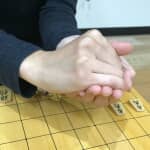27 June 2019
Bible of Handicap Game –Special Episode “Tombo” (Ibisha)–
A series of articles named “Bible of Handicap Game” provides you a good knowledge of learning points and goals in several types of handicap games, Koma Ochi. In this special episode, you are learning a Tombo, or dragonfly, handicap. In a Tomobo handicap situation, a handicap giver has Fu (Pawn), Hi (Rook) and Kaku (Bishop) other than Ou (King). The formation is similar to the shape of a dragonfly and this handicap is called Tombo.
Tomobo is challenging for Shogi beginners when they play with an instructor, since the instructor is going to have two major pieces, Hi (Rook) and Kaku (Bishop). Students who learn Shogi at i-tsu-tsu Motomachi classes named this handicap as “Tomobo from hell” after struggling with it.

Techniques which will be acquired through learning a Tombo handicap are useful to play an even game. This is why i-tsu-tsu Shogi class has included Tomobo in the curriculum for Shogi beginners.
When children play at tournaments, sometimes they will be classified by their skills but they hardly play a handicap game. We want children to be familiar with a game without a handicap.
In this situation, since their opponent has major pieces, you may follow the basic theory to move pieces during an opening and a middle game. And then, once you can break through an opponent’s camp, it wouldn’t be very difficult to get close to Ou (King) who is not with protections of bodyguards, Kin (Gold).
I am going to tell you how to play a game with a Tombo handicap. Learn well and use knowledge being discussed here!
Today’s handicap will be shown in Ibisha situation.
Previous Related Articles:
Bible of Handicap Game –10 Pieces Dropped, without Fu (Pawn)–
Bible of Handicap Game –10 Pieces Dropped–
Bible of Handicap Game –9 Pieces Dropped–
Bible of Handicap Game –Tombo (with Ibisha Tactics)–
Until the last article, Bible of Handicap Game –8 Pieces Dropped–, you have learned how to catch your opponent off guard to make attacking while a handicap giver is focusing on protecting his/her Ou (King). On the other hand, in this Tombo handicap situation, the handicap giver has two major pieces. That means since he/she has attacking force, you need to have knowledge of not only the way to attack but also the way to protect your pieces and the way to make an ideal piece-formation.
Goal to Be Achieved through Learning a Tombo Handicap (with Ibisha Tactics)
• Protect Kaku (Bishop) from attacking the squares ahead of it
• Get to understand how to move Gin (Silver) as Bou Gin (a kind of attacking strategy, where Gin (Silver) advances along its Hisha’s (Rook’s) file
• Break through an opponent’s camp attacking from squares ahead of Hisha (Rook)
Protect Kaku (Bishop) from Attacking from Above
In a Tombo handicap situation, a handicap giver has attacking pieces and aim at entering your camp moving his/her Fu (Pawn) placed ahead of Hisha (Rook), △P-8d and △P-8e. Against these moves, you may want to move Fu (Pawn) first, ▲P-2f, and then move Kin (Gold), ▲G-7h.
The purpose of moving Kin (Gold) is to prepare for Hi’s (Rook’s) attack to your Kaku (Bishop). Kaku (Bishop) can move any number of squares diagonally, but vertically. Not moving vertically is the biggest weak point of Kaku (Bishop). I often tell students, “Kaku‘s (Bishop’s) top is like a plate on the head of Kappa“. (Kappa is a Japanese imaginary creature who lives in water and has a plate on its head. The plate is his weak point.) Keep in mind that moving Kin (Gold), ▲G-7h will result in protecting the square of 8g. This is a technique so called “Number based attack”. The number mentioned here is that of pieces which have reaching power to a certain square. By moving Kin (Gold), ▲G-7h, you can add reaching power to the square of 8g against attacking.

Let’s see what is the next after moving Kin (Gold), ▲G-7h.
A player who gave a handicap is going to move Fu (Pawn), △P-8f. You are supposed to take this piece with Fu (Pawn) of yours, ▲Px8f. This is a quite predictable capture for instructors, but there are not a few students who are hesitate to take the Fu (Pawn) at the square of 8f. I always ask why they can’t take it and most students say, “Because if I take the Fu (Pawn), the opponent’s Hisha (Rook) will take the piece I used. When I hear this reason, I tell them if you won’t take your opponent’s Fu (Pawn), the Fu (Pawn) will get promoted and attack your pieces in your camp.
After that, the opponent’s Hisha (Rook) on the 8th file is going to come close to your camp, △Rx8f. In this situation, you must drop Fu (Pawn), ▲P*8g. This is an important drop but making this drop is also somehow challenging for many students.
This series of events is quite common in an Ibisha situation under an even game. During the events, Shogi beginners often allow an opponent’s Fu (Pawn) to get promoted and lose a game. To prevent this from happening, I tell students to memorize the entire steps I described above.
If your purpose is only to protect the square of 8g, moving Gin (Silver), ▲S-7h, also is going to work. Even so, because moving Kin (Gold), ▲G-7h, is a standard move against attacking when you play an even game, I highly recommend acquiring all you’ve learned.
Attack with Bougin
I explained how to protect your camp against attacks made by pieces on an opponent’s Hisha’s (Rook’s) file. That was about defense. As you know, you can’t win a game without offense. You need both of them.
In the previous article, you learned how to target an opponent’s weakest point , Bible of Handicap Game –8 Pieces Dropped–. You got to know the way to use Kyo (Lance) and attack from the edges. In this situation, on the contrary, since an opponent also has major pieces, it’s not good idea to attack from the edges. Here, a more practical idea is to build an ideal piece formation. (You can learn about an ideal piece formation in our text book, “Shogi Lesson Book for Beginners Vol. 3”, on the page of Day 81.
When you are building an ideal piece formation, you need to move Gin (Silver) to the 5th rank.
I’m going to tell you moves you will make; first, move Gin (Silver) to the square of 3h, ▲G-3h, and then ▲G-2g, ▲G-2f, and ▲G-3e. Gin (Silver) proceeds all at once to the 5th rank. This is one of tactics called Bougin, climbing Gin (Silver), where you move Gin (Silver) to the 5th rank in the beginning of a game. This is what I want children to learn first. You may have an aim to exchange pieces of Fu (Pawn) ahead of Hisha (Rook). I would say it won’t work. Because the opponent moved Hisha (Rook) to the square of 8d and reaching power of this Hisha (Rook) covers all squares on the 4th rank, you moving Fu (Pawn), ▲P-2d will become unsuccessful.
If you are in the situation in which you can exchange pieces of Fu (Pawn) successfully, you may move Gin (Silver) as ▲G-2g, ▲G-2f, and ▲G-2e, instead of ▲G-2g, ▲G-2f, and ▲G-3e.
The most important thing here is not to realize procedures or theories in details, but just to realize moving Gin (Silver) to the 5th rank is leading to an “ideal” formation. You could say you never fail to have the situation during a real even game, where Bougin is used. This is why I want Shogi beginner children to make this technique theirs.


Supposedly, your opponent is going to aim to make his/her Kaku (Bishop) get promoted and to enter your camp while you are attempting to enter his/her camp. He/She will move Fu (Pawn), △P-1d, and Kaku (Bishop), △B-1c. What you have to keep in your mind during a game with a Tombo handicap is to be aware of reaching power your opponent’s major pieces have. (When you play a game with a 8-piece handicap, or a 6-piece handicap, since your opponent doesn’t have major pieces, but Kin (Gold) or Gin (Silver), you don’t need to worry about threat of reaching power from a long distance.) Against the Kaku’s (Bishop’s) attacking, move Gyoku (King) as ▲K-6h.

Break through an Opponent’s Camp by Number-based Attack
Once you’ve moved Gin (Silver) to the 5th rank and finished forming an ideal piece-formation, you are ready to attack your opponent’s camp. Following a theory, let’s aim at breaking through the camp with Fu (Pawn) ahead of Hisha (Rook).
After you moving Fu (Pawn), ▲P-2d, look at the number of pieces whose reaching power covers the square of 2c. The opponent has one piece, Gyoku (King), meanwhile you have two pieces, Fu (Pawn) and Hisha (Rook). Since you have more pieces which are influential to the square of 2c, you will be able to enter the camp successfully; ▲P-2d△Px2d▲Sx2d△K-4b▲S+2c.


What you are going to do now is to chase down your opponent’s Gyoku (King); △B-3a▲+Sx3c△K-5b▲R+2a△B1c▲+R-3b△K-6a▲+Sx4c△K-7a, ▲B+3c…. Since your opponent doesn’t have defensive pieces such as Kin (Gold) and Gin (Silver), it’s not going to be difficult to capture Gyoku (King).
We’ve learned a type of handicap games, Tombo, in the situation where Ibisha is used.
Tombo handicap games are not easy to win for players who are given a handicap. They need to observe a Shogi board widely, being careful about their opponent’s major pieces of Kaku (Bishop) and Hisha (Rook).
In a Tombo handicap game, a stronger player has major pieces and the game is relatively advantageous for him/her. For Shogi beginners, it is challenging to be aware of reaching power of an opponent’s pieces. In spite of these, I teach Tombo to children hoping them learning the basic knowledge used in an even game such as the way to protect the top of Kaku (Bishop) and Bougkin tactics.
If children can win a Tombo handicap game without any aid, it would be just wonderful. However, for a while, I would recommend checking if children can perform the steps described above.
The title of the next article is going to be “Bible of Handicap Game –Special Episode “Tombo” (Furibisha)–”. You are learning a Tombo handicap in a Furibisha situation. Don’t miss it!
Bougin is a key technique to win a Tombo handicap game and a useful technique to play a game without a handicap.
For your information, you may find detailed information about Bougin in “Shogi Lesson Book for Beginners Vol. 3”.
Shogi Lesson Book for Beginners Vol. 3



